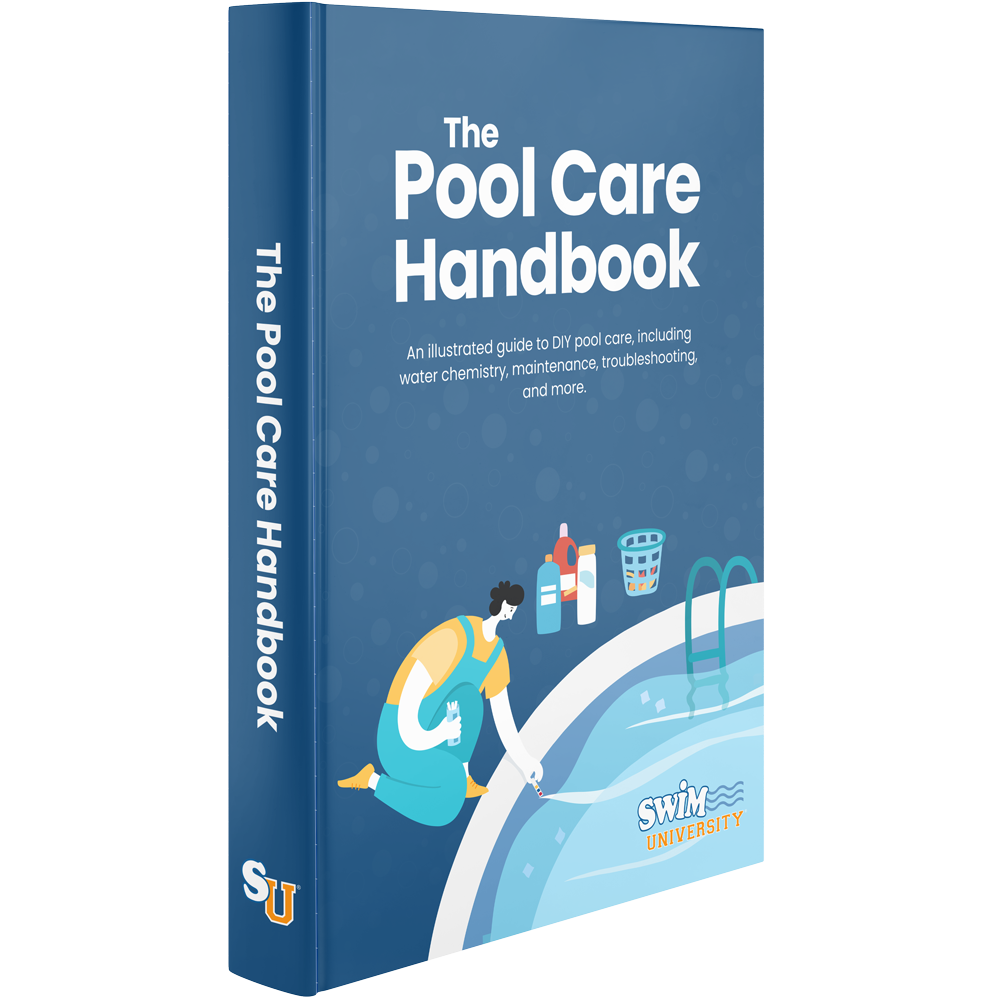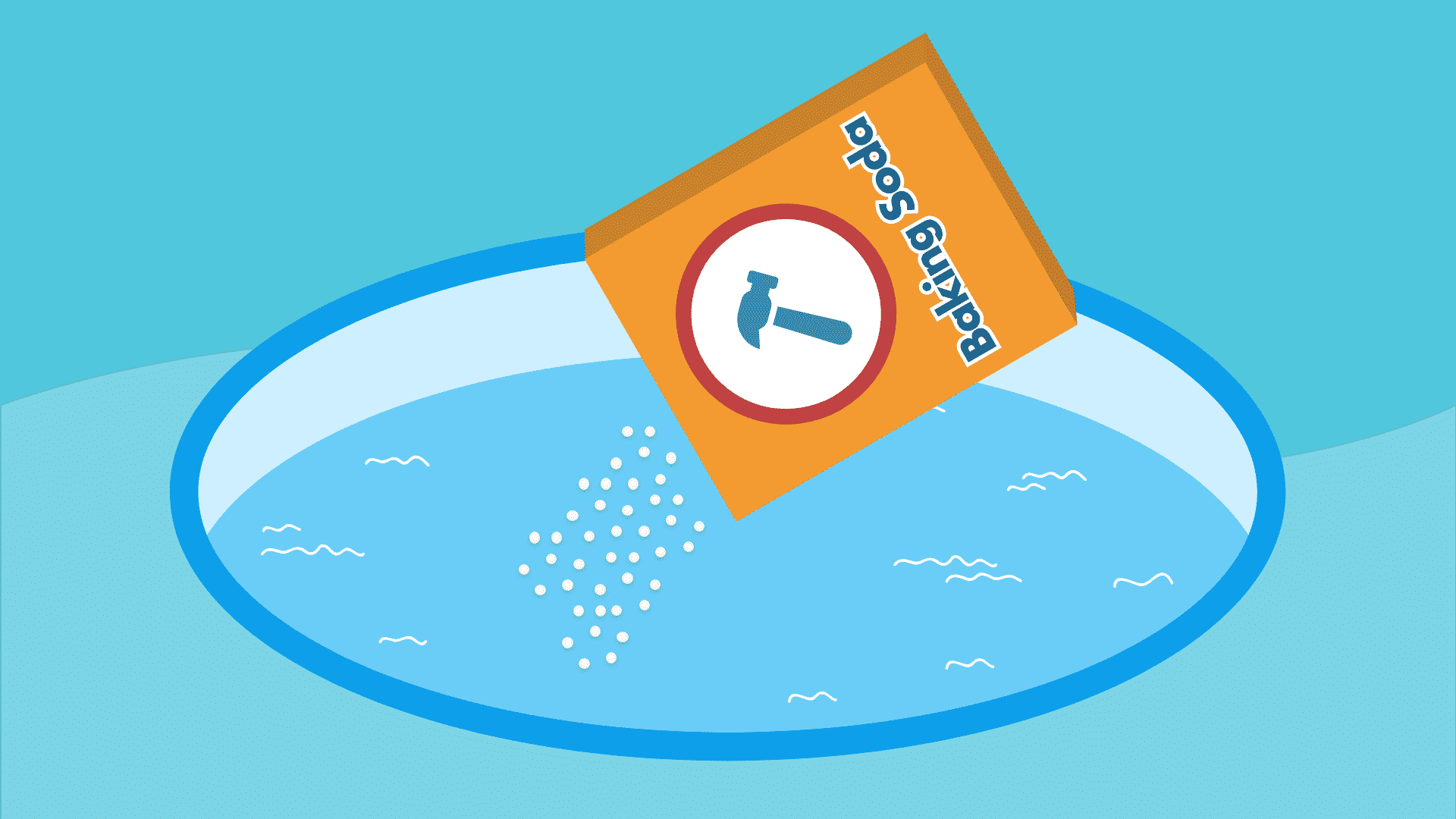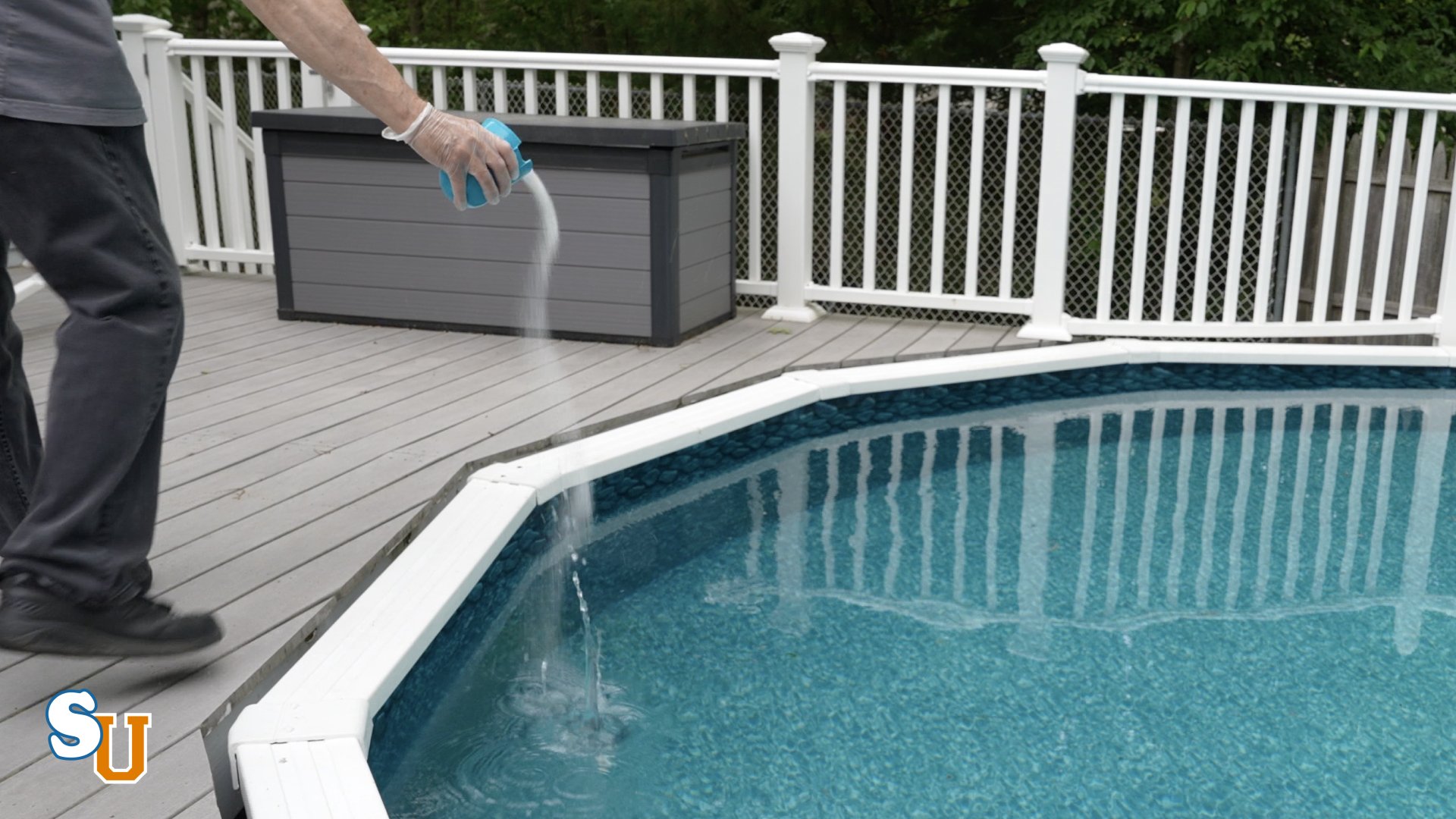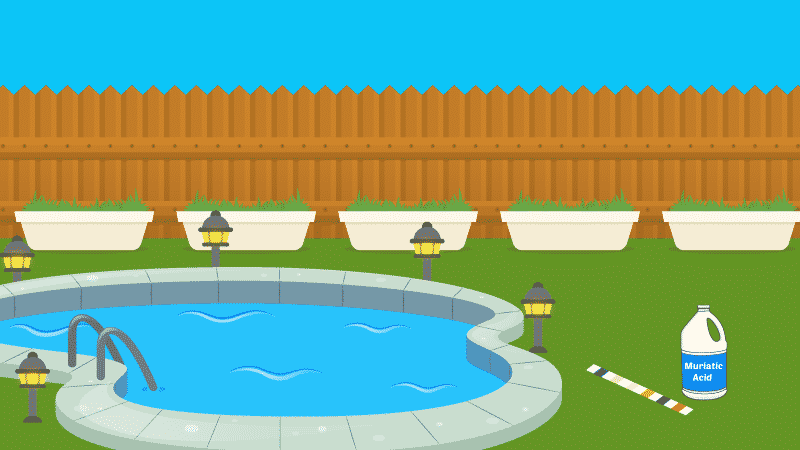How to Lower pH in a Pool Quickly with These Common Chemicals
Is the pH in your pool too high? If the levels stay high for too long, you might notice itchy eyes and skin, cloudy water, algae growth, and even damaged pool parts. So you’ll need to add some pool chemicals ASAP to bring your pH back down to normal levels. There are two ways to lower pH in a pool: pH decreaser (sodium bisulfate) or muriatic acid.
Check out our video tutorial below or keep reading for the complete guide.
This is the ultimate guide to keeping your pool sparkling clean throughout the year that contains everything you need to know about taking care of your pool the right way. Including saltwater pools.
For a quick chemistry refresher, pH measures whether a substance is basic or acidic. The pH scale ranges from 0 to 14, where 7 is neutral, anything that measures below 7 is acidic, and anything that measures above 7 is basic. When properly balanced, your pool’s pH needs to be between 7.4 and 7.6.
Everything that enters the pool has the potential to affect pH level – even the swimmers themselves. Things like rain, dirt, and debris in your water can also knock things out of balance. And even saltwater systems generate naturally high pH levels. So, because pH is so volatile, it’s important to regularly test your pool’s pH levels as part of your pool maintenance routine.
Keep reading for a complete guide on what affects your pH and how to lower pH in a pool with
How Do pH and Total Alkalinity Affect Each Other?
Your total alkalinity and pH levels go hand in hand. And it’s your alkalinity that helps keep your pH level stable. Without this buffer, the pH would wildly fluctuate. When your total alkalinity is too low, the pH becomes unstable. And when it’s too high, it can bring up your pH levels with it.
That’s why adjusting your alkalinity before adjusting your pH is so important: it can help bring your pH into range. Your total alkalinity should be between 100 and 150 parts per million (ppm). If you find that your total alkalinity is too low, but you have a pH higher than 6.8, use an alkalinity increaser. If your total alkalinity is too high, using a pH decreaser or pH reducer like sodium bisulfate will bring down both your alkalinity and pH.
Stop wasting time and money with confusing water chemistry and maintenance. Our effortless system guarantees to keep your pool balanced, sanitized, and crystal clear all year. Works for all pools including saltwater.
What Happens if Your Pool pH is Too High?
Once your pH level reaches 7.8 or higher, that’s considered high pH. If your high pool water pH is left alone too long, it can lead to a number of issues, including eroding pool parts and affecting swimmers themselves.
Reduces Chlorine Effectiveness
When the pH is too high, your pool’s chlorine won’t be able to clean the water as effectively. You’ll need to use more chlorine to get the same effect as before, which can affect the rest of your pool’s chemical balance. Without chlorine working effectively to kill microbes, you could end up with an algae bloom. And you may also end up with calcium buildup, which can lead to cloudy water and damaged pool equipment.
Irritates Eyes and Skin
High pH may cause swimmers to have itchy, red eyes. They may experience skin irritation, as well. So, while many people think that high chlorine levels cause eye and skin irritation, it’s really high pH.
Erodes Swimsuits and Swimmer Gear
The high pH isn’t good for your swimsuits or goggles. Over time, the chemical imbalance may cause your swimsuit to fade or degrade the fabric to the point where you can’t wear the suit anymore. Goggles may weaken and break sooner than you’d expect.
Damages Pool Equipment
The high pH will lead to calcium scale buildup, not just on the walls of your pool but also on your pool equipment. The buildup could clog up equipment and block water flow in and out of the pool. This can introduce air into the pool pump, which will cause malfunction and may render it useless.
How to Lower pH with pH Decreaser (Sodium Bisulfate)
Most commercial pH decreasers, like pH Down or pH minus, are made with sodium bisulfate, also known as dry acid. They’re safer and less corrosive to use than muriatic acid, but they generally cost more.
Use this chemical to lower just the pH level in your pool water.
Avoid adding it to your pool on a windy day, as this increases the chance the powder will blow back into your face while you are using it.
1. Test Your Water
Start by testing your pH and alkalinity levels so you know how much you need to lower everything. If your total alkalinity is also too high, don’t worry: the
2. Measure Out the pH Decreaser
Read and follow the manufacturer’s directions to figure out how much
It’s okay to use less and add more later. Remember, it’s easier to add more to correct your water balance than to adjust the pool chemistry if you add too much.
3. Add the pH Decreaser to Your Pool
Pour the chemical directly into your water near the return jets and in the deepest end of your pool. Keep the pump running. Do not add it to the skimmer. If you’re a pool owner with an above ground pool, you may need to help stir the water yourself with a pool brush.
4. Let the pH Decreaser Dissolve
Allow your pool’s filtration system to circulate the chemical throughout the water and dissolve. You may want to brush away any undissolved clumps off of your pool’s surfaces, or it can damage your pool walls and pool floor.
5. Retest Pool Water, Repeat As Needed
Immediately retesting your water isn’t necessary, but make sure you complete another test within 24 hours. If your pH and total alkalinity are within the normal range, congratulations! But, if you find they’re still high, repeat the process again.
How to Lower pH with Muriatic Acid
Muriatic acid, also known as hydrochloric acid, is a highly corrosive and dangerous chemical. So if you opt for this method to lower your pH, you’ll need to take extra precautions. Cover your body completely with clothing. And wear thick gloves, safety goggles, and a mask to avoid breathing in fumes. Even though it’s not a powder, you still want to avoid a windy day because of blowback and splashback.
Used for lowering alkalinity and pH in your pool water. It's also used for cleaning pool filter grids, filter cartridges, and concrete pool surfaces.
1. Test Your Water
Test pH and total alkalinity so you know how much you need to lower both levels. Muriatic acid will lower both pH and alkalinity together. But they may decrease at different rates.
2. Measure Out the Muriatic Acid
Calculate how much muriatic acid you need to lower your pH to the normal range. If your pH reading is above 7.8 and you have a 15,000-gallon pool, start by adding 1 quart (1/4 gallon) of muriatic acid. Then after letting the acid circulate for one hour, retest your levels. If you have a smaller pool, start by adding one cup of muriatic acid at a time. Wait for one hour, then add more as needed. Check out our chart below on how much muriatic acid to add based on your pH levels and pool size.
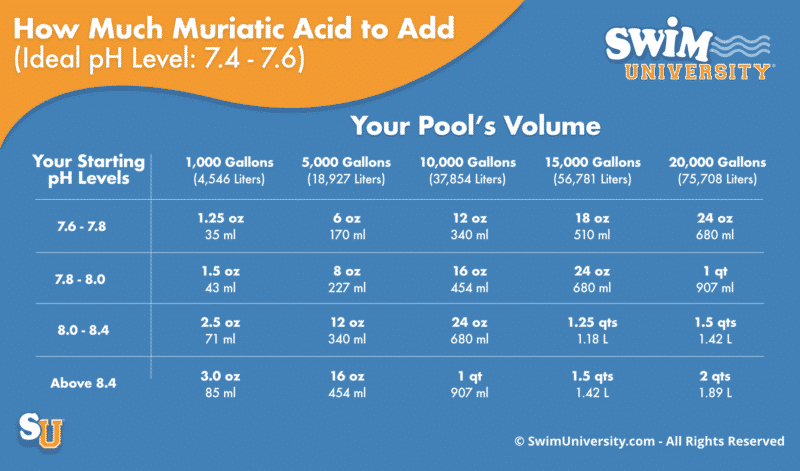
3. Add Muriatic Acid to your Pool Water
Because this is an acid, it can damage your pool liner if it starts to collect in one place. So always run your filter to keep your water circulating (ideally on the circulate setting). Remember, you can always add more acid later so start slowly!
It’s easier and safer to handle muriatic acid if you dilute it in a bucket of water first. The ideal ratio of water to muriatic acid is 10:1 but always follow the manufacturer’s instructions. And be sure to add the water before adding muriatic acid to avoid splashback.
- Method One: Turn off the pool’s pump and add the muriatic acid in a small, steady stream directly into the deep end of your pool. This ensures the acid will go directly to the bottom, rather than floating around at the pool surface. Then turn your pump on and let it circulate the acid through the water.
- Method Two: Slowly pour the acid into the pool near your return jets and let the pump circulate it. For above ground pools, add the acid slowly by walking around your pool so it doesn’t get concentrated in a single spot.
If you want more help safely adding muriatic acid to your pool, be sure to check out our guide.
4. Let the Muriatic Acid Dissolve
Keep your pool’s filter running (ideally on circulate) and let the chemical dissipate. It should be dissolved within an hour. But it could take longer if you’ve had to add a large dose.
5. Test Your Water Again
Test the pH and alkalinity again after an hour or two. If the levels are still high, repeat the process again, adding a little bit of muriatic acid at a time.
It should be okay to swim after one hour of pool circulation if you’ve only added a little muriatic acid. But if you’ve added a larger quantity, wait 24 hours before retesting your water and swimming.
What If the pH and Alkalinity Won’t Balance?
It’s not uncommon for either your alkalinity or pH to remain unbalanced after adding
If both your pH and alkalinity levels are too low, you can add soda ash to help bring them up. But what if you only need to bring your pH into range?
You can increase your pH levels without affecting your alkalinity by using pool aeration (see our pool aeration guide for more information). Using a water fountain or pool aerator will create bubbles that help outgas carbon dioxide in the water. As carbon dioxide leaves the water, the pH will rise without impacting your total alkalinity. And if you need to bring down your alkalinity, you can add more acid while aerating your water to keep your pH levels up.
Frequently Asked Questions About How to Lower pH in a Pool
Need more help lowering the pH in your swimming pool? Here are a few common questions and answers.
How do I lower the pH in my pool naturally?
Lowering a pool’s pH naturally can be done in four ways: installing a distilled water system to pump in water, cleaning your pool on a regular basis, leaving it alone, and letting the pH level come down on its own as minerals build-up, or installing a pool heater. The heated water will be able to dissolve natural substances better than cooler water. No matter what, you still need to use test strips or a testing kit to check levels regularly and prevent them from coming down too low.
What happens if pH is too high in a pool?
When the pH is too high in your pool, your chlorine won’t sanitize the water as effectively. Swimmers may experience eye redness and irritation. Bathing suits and goggles may fade and wear faster than normal.
Can you swim in a pool with high pH?
It’s not recommended to swim in a pool with high pH. When your pool’s pH is high, the chlorine won’t work as effectively to kill bacteria. And high pH levels can irritate swimmers’ eyes and skin.
Will shocking pool lower pH?
Adding shock can actually raise your pH levels. If you use a calcium hypochlorite (cal-hypo) shock, this can raise your pH levels temporarily. So test your chemical levels regularly, especially after shocking.
Does vinegar lower pool pH?
Vinegar contains acetic acids, which are helpful for lowering pH. However, the problem with this approach is that you would need a lot (several gallons) of vinegar to address pH issues in your pool. And when used in high amounts, the vinegar will leave behind sugars and other impurities. The sugars become food for microbes present in the water, and the impurities may affect your pool’s chemistry.
Will baking soda lower pH in a pool?
Adding baking soda to your pool will actually raise the pH and alkalinity of your pool water. Baking soda, better known as sodium bicarbonate, is naturally alkaline, with a high pH of 8.
4 Ways We Can Help With Your Pool
- Pool Care Cheat Sheets (Free): Easy-to-use downloadable guides to help you keep track of taking care of your pool this year.
- The Pool Care Handbook: An illustrated guide to DIY pool care, including water chemistry, maintenance, troubleshooting, and more.
- The Pool Care Video Course: You’ll get 30+ step-by-step videos and a downloadable guide with everything you need to know about pool maintenance.
- The Pool Care App: Enter your water test results. Get a custom treatment plan. Know exactly what chemicals to add to keep your pool clear.

